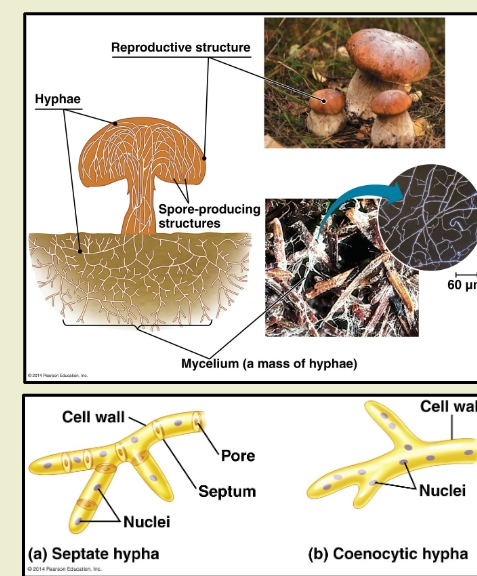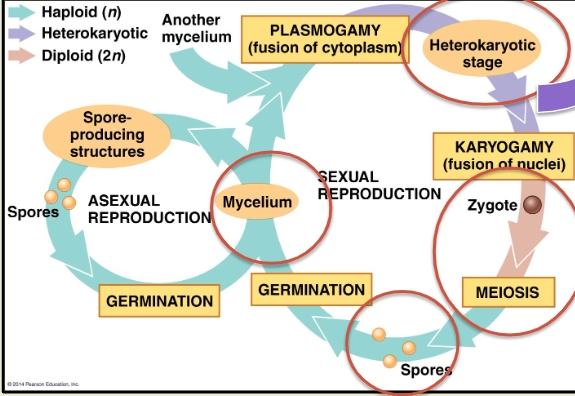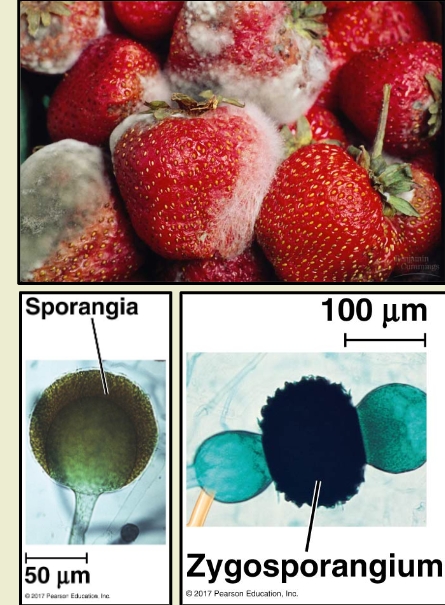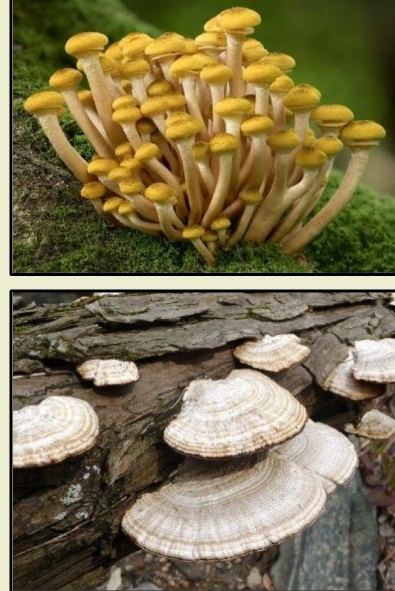History of Life: Colonization of Land by Fungi
1/17
There's no tags or description
Looks like no tags are added yet.
Name | Mastery | Learn | Test | Matching | Spaced |
|---|
No study sessions yet.
18 Terms
Importance of Fungi
Importance of Fungi 1. Ecological Role 🌱
Decomposers – Recycle nutrients by breaking down organic matter.
Symbiotic relationships –
Mycorrhizae: Help plant roots absorb water & nutrients.
Lichens: Partner with algae/cyanobacteria for survival.
Pathogens & Pest Control – Cause plant diseases but also control pests.
2. Role in Human Health & Welfare 🏥🍞
Medicine – Source of antibiotics (penicillin) & other drugs.
Food Industry – Used in bread, cheese, beer, wine, and soy sauce.
Biotechnology – Used in genetic engineering & enzyme production.
Diseases – Cause infections in humans (athlete’s foot, yeast infections) and plants (rusts, smuts).
Fungi are crucial for ecosystems, medicine, and industry! 🍄
Ecological role
Critical Role in Nutrient Cycling (Ecological Role) 🌿♻
Many fungi are:
Saprophytes – Decomposers that break down dead organic matter.
Break Down Cellulose & Lignin – Help recycle nutrients by decomposing tough plant materials, returning carbon and nitrogen to the ecosystem.
Fungi are essential for maintaining soil health and ecosystem balance! 🍄
Fungi in Symbiotic Relationships (Ecological Role) 🌱🍄
Fungi & Photosynthetic Organisms –
Mycorrhizae: Fungi help plant roots absorb water & nutrients.
Lichens: Fungi partner with algae or cyanobacteria for survival.
Fungi & Animals –
Help in digestion (e.g., fungi in termite and ruminant guts).
Provide shelter and food for some insects.
Ecological Role
1. Importance of Fungi
✅ Ecological Role – Nutrient cycling, decomposition, and symbiosis.
✅ Role in Human Health & Welfare – Medicine, food production, biotechnology, and disease.
2. Critical Role in Nutrient Cycling ♻
Saprophytes – Decompose organic matter.
Break Down Cellulose & Lignin – Recycle essential nutrients in ecosystems.
3. Fungi in Symbiotic Relationships 🌱🍄
With Photosynthetic Organisms –
Mycorrhizae: Help plant roots absorb nutrients.
Lichens: Partner with algae/cyanobacteria for survival.
With Animals – Aid digestion in insects and herbivores.
4. Types of Symbiotic Fungi
Endophytic Fungi – Live inside plants, providing protection.
Mycorrhizae – Mutualistic relationship with plant roots.
Ectomycorrhizal Fungi (EMF) – Form sheaths around roots.
Arbuscular Mycorrhizal Fungi (AMF) – Penetrate root cells to exchange nutrients.
Fungi are essential for life on land, shaping ecosystems and benefiting humans! 🍄
4o
Ecological role
Lichens are symbiotic associations between fungi (usually from Ascomycota) and green algae or cyanobacteria. The fungi provide structure and protection, while the algae or cyanobacteria perform photosynthesis, supplying the partnership with organic nutrients.
Ecological Role of Lichens:
Pioneer Species: Help in soil formation by breaking down rocks.
Bioindicators: Sensitive to air pollution, used to monitor environmental health.
Nutrient Cycling: Contribute to ecosystems by fixing nitrogen (in cyanobacterial lichens) and decomposing organic material.
Types of Lichens:
Foliose – Leaf-like, with lobed structures (e.g., Parmelia).
Fruticose – Shrubby or hair-like, often branched (e.g., Usnea).
Crustose – Crusty, tightly attached to surfaces like rocks (e.g., Graphis).
Ecological Role
Ecological Role of Fungi – Additional Mutualisms & Impacts
✅ Mutualism with Herbivores – Some fungi live in the digestive tracts of herbivores (e.g., cows, termites) to help break down plant material.
✅ Ant Fungal Farmers – Leaf-cutter ants cultivate fungi as a food source, feeding them plant material while the fungi break it down.
✅ Decline in Frog Populations – Batrachochytrium dendrobatidis (a chytrid fungus) is responsible for severe declines in amphibian populations worldwide.
✅ "Mind-Control" Fungus – Parasitic fungi, like Ophiocordyceps, infect insects (e.g., ants), altering their behavior to spread fungal spores.
Fungi have diverse ecological impacts, from mutualisms to parasitic control!
Role in Human Health and Welfare
Role of Fungi in Research & Economic Importance
Fungi are vital in medicine, agriculture, industry, and space research, contributing significantly to the economy:
Medical & Biotechnology: Used in antibiotics (penicillin), antifungal drugs, vaccines, and genetic research, driving the pharmaceutical industry.
Agriculture & Environment: Mycorrhizal fungi improve soil fertility, boosting crop yields, while fungi aid in bioremediation and pest control, reducing agricultural losses.
Industry & Food Science: Essential in fermentation (beer, wine, cheese, bread), enzyme production, and biofuels, generating billions in global markets.
Space Research: Studied for survival in extreme environments and potential space farming, supporting future space economies.
Role of Fungi in Food and Beverages
Fungi are essential in food production, fermentation, and flavor enhancement:
Fermentation: Yeast (Saccharomyces cerevisiae) is used in making bread, beer, wine, and soy sauce by fermenting sugars.
Dairy & Cheese: Fungi like Penicillium are used in blue cheese (P. roqueforti) and Camembert (P. camemberti) to enhance flavor and texture.
Traditional Foods: Fungi are used in tempeh (fermented soybeans), miso, and sake production.
Food Preservation: Some fungi produce natural preservatives and enzymes that extend shelf life and improve food quality.
Fungi
Fungi Overview
97,000 species identified, but many remain undiscovered.
Poorly studied compared to other organisms.
Mycology: The scientific study of fungi.
Eukaryotic organisms that grow as single cells (yeasts) or multicellular filaments (hyphae forming mycelium).
Absorptive feeders (heterotrophic/chemoheterotrophs): Obtain nutrients by secreting enzymes and absorbing organic material.
Decomposers: Break down dead organisms (e.g., Saprotrophic fungi).
Parasites: Infect and feed on living hosts (e.g., Athlete’s foot fungus).
Mutualists: Form beneficial relationships (e.g., mycorrhizal fungi with plants).
Fungi play key roles in medicine, research, industry, and the environment.
Fungal Morphology
Fungal Morphology
Fungi exhibit two main growth forms:
Yeasts: Unicellular, round or oval-shaped fungi that reproduce by budding or fission (e.g., Saccharomyces cerevisiae).
Multicellular fungi with mycelia: Composed of hyphae (thread-like structures) that form a network called mycelium, allowing for nutrient absorption and growth (e.g., mold, mushrooms).
Cell walls made of chitin: Provides structural support and protection, similar to arthropod exoskeletons.
Hyphae Types:
Septate hyphae: Have cross-walls (septa) with pores that allow cytoplasm and organelle movement.
Coenocytic hyphae: Lack septa, forming a continuous multinucleate cell.
The storage of starch is stored as glycan.

Fungal Morphology
Fungal Structure and Efficiency
Highest surface area to volume ratio of multicellular organisms, thanks to the extensive network of hyphae.
They are extremely thin and have a lot of area to cover with very little volume
Upside: This structure makes fungi extremely efficient at absorbing nutrients from their environment.
Downside: The large surface area leads to a higher rate of water evaporation, making fungi sensitive to changes in moisture. Drys out very quickly. So, they are found in areas that maintain moisture.
Fungal Reproduction
Fungal Reproduction
Spores are the primary reproductive cells of fungi, capable of surviving in harsh conditions and germinating when favorable conditions return. They do not have gametes (egg and sperm). So, they are never classified as male or female.
Mating Types: Hyphae of fungi have different mating types (similar to sexes in animals), which must fuse for sexual reproduction. This ensures genetic diversity. They don’t actually reproduce unless hungry.
Haploid Cells in Fungal Reproduction
Haploid cells: Fungi typically have a haploid phase, where the cells contain a single set of chromosomes.
Haploid spores are produced during asexual reproduction.
During sexual reproduction, haploid cells from different mating types fuse to form a dikaryotic (two nuclei) or diploid cell, which eventually undergoes meiosis to produce new haploid spores.
Fungi can reproduce sexually (via spore production after mating) or asexually (through spore formation without fusion).
Fungal reproduction
Fungal Reproduction Stages (Sexual reproduction cycle)
Plasmogamy: The fusion of cytoplasm from two different haploid cells (hyphae) of different mating types. This leads to the formation of a heterokaryotic hypha, where each cell has two distinct nuclei (one from each parent).
Heterokaryotic hyphae: Hyphae containing genetically distinct nuclei that haven't yet fused.
Dikaryotic hyphae: A type of heterokaryotic hypha where each cell contains exactly two different nuclei (one from each parent).
Karyogamy: The fusion of the nuclei (from the dikaryotic hyphae), resulting in a diploid cell. This is a key step before meiosis occurs, leading to the production of new haploid spores. That germinate into a new mycelium.

Fungi Phylogeny
Fungi Phylogeny
Eukaryotic Supergroup Unikonta: Fungi are included in this group, which also contains animals and some protists. Closely related to animals.
Nucleariids: These amoeba-like protists are the closest living relatives of fungi, supporting the idea that fungi share a common ancestor with them.( absorptive feeders)
Terrestrial Fungi: Fungi are believed to have first evolved on land around 460-480 million years ago, marking a significant adaptation from aquatic environments to terrestrial ecosystems.
Cryptomycetes and Microsporidians
Cryptomycetes and Microsporidians
These are basal lineages of fungi, representing some of the earliest-diverging groups within the fungal phylogeny:
Cryptomycetes
Parasites: Primarily parasitic on protists and other fungi.
Unicellular: They are typically unicellular with flagellated spores for movement.
Ecology: Often associated with aquatic environments, but also found in terrestrial habitats.
Microsporidians
Parasites: Infect protists and animals, including humans.
Unicellular: These fungi are unicellular with unique spores that contain a harpoon-like organelle used to inject their genetic material into host cells.
Small Genomes: They have very small genomes, a characteristic related to their parasitic lifestyle
Phylum Chytridiomycota
Phylum Chytridiomycota
Diverse Ecological Roles:
Decomposers: Break down organic material in aquatic and terrestrial environments.
Mutualists: Form beneficial relationships with plants or other organisms.
Parasites: Infect protists, fungi, plants, and animals.
Unicellular with Flagellated Spores: Chytrids produce zoospores, which are flagellated spores that allow them to move in water.
Amphibian Decline: Some chytrids, like Batrachochytrium dendrobatidis, are responsible for amphibian population declines globally, causing a disease called chytridiomycosis.
Chytrids are one of the most primitive fungal groups, with both aquatic and terrestrial members.
Phylum Zoopagomycota
Phylum Zoopagomycota
Ecological Roles:
Parasites: Affect animals, other fungi, and protists.
Commensal Symbionts: Some species live in mutualistic or commensal relationships with animals.
Filamentous Hyphae: Fungi in this phylum form filamentous hyphae similar to other molds.
Non-Flagellated Spores: They produce non-flagellated spores rather than zoospores.
Reproduction:
Sexual reproduction involves the formation of a zygosporangium, where two haploid cells fuse to form a diploid zygote.
Asexual reproduction occurs through the formation of conidia (asexual spores).
Zoopagomycota play important roles in food webs as parasites or symbionts.
Phylum Mucoromycota
Phylum Mucoromycota Overview
Characteristics:
Fast-growing molds
Act as decomposers, mycorrhizal partners, and plant pathogens
Structure:
Have coenocytic hyphae (hyphae without cross walls—continuous cytoplasm) don’t have separation between cells
Reproduction:
Asexual:
Uses lollipop-shaped sporangia
Produces non-flagellated spores
sexual:
Forms a zygosporangium during reproduction
(a thick-walled structure that protects spores during harsh conditions)

Phylum Ascomycota
Structure: Sac-like
Septate hyphae (divided by cross walls)
Non-flagellated spores
Asexual Reproduction:
Produces conidia (asexual spores)
Conidia form on special hyphae tips called conidiophores
Sexual Reproduction:
Produces ascospores inside saclike asci
Asci are contained within fruiting bodies called ascocarps
Has an extensive dikaryotic stage (two nuclei per cell before fusion)
Examples/Importance:
Includes:
Yeasts
Plant pathogens
Lichens (fungus + photosynthetic partner)
Antibiotic producers (e.g., Penicillium)
Phylum Basidiomycota
Phylum Basidiomycota – “Club Fungi”
Structure:
Septate hyphae
Non-flagellated spores
Reproduction:
Mostly sexual reproduction
Produces basidiospores (sexual spores)
Spores form on club-shaped basidia
Basidia are found inside basidiocarps (fruiting bodies like mushrooms)
Has an extensive dikaryotic stage (cells with two nuclei before fusion)
Ecological Role:
Important decomposers of wood and plant material
Examples:
Edible mushrooms
Shelf fungi
Rusts and smuts (plant pathogens)
